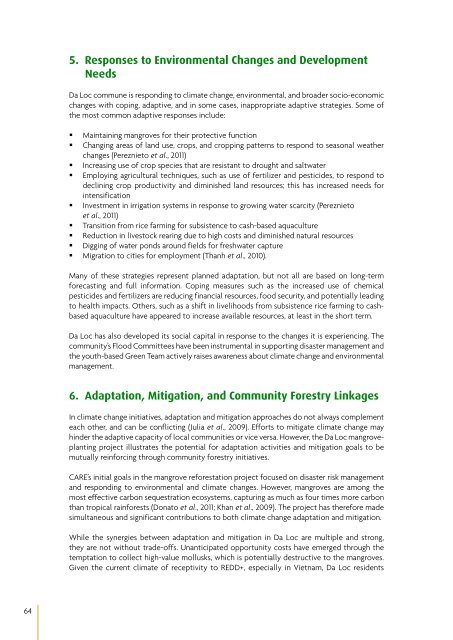Adaptation case studies.pdf - RECOFTC
Adaptation case studies.pdf - RECOFTC
Adaptation case studies.pdf - RECOFTC
You also want an ePaper? Increase the reach of your titles
YUMPU automatically turns print PDFs into web optimized ePapers that Google loves.
5. Responses to Environmental Changes and DevelopmentNeedsDa Loc commune is responding to climate change, environmental, and broader socio-economicchanges with coping, adaptive, and in some <strong>case</strong>s, inappropriate adaptive strategies. Some ofthe most common adaptive responses include:• Maintaining mangroves for their protective function• Changing areas of land use, crops, and cropping patterns to respond to seasonal weatherchanges (Pereznieto et al., 2011)• Increasing use of crop species that are resistant to drought and saltwater• Employing agricultural techniques, such as use of fertilizer and pesticides, to respond todeclining crop productivity and diminished land resources; this has increased needs forintensification• Investment in irrigation systems in response to growing water scarcity (Pereznietoet al., 2011)• Transition from rice farming for subsistence to cash-based aquaculture• Reduction in livestock rearing due to high costs and diminished natural resources• Digging of water ponds around fields for freshwater capture• Migration to cities for employment (Thanh et al., 2010).Many of these strategies represent planned adaptation, but not all are based on long-termforecasting and full information. Coping measures such as the increased use of chemicalpesticides and fertilizers are reducing financial resources, food security, and potentially leadingto health impacts. Others, such as a shift in livelihoods from subsistence rice farming to cashbasedaquaculture have appeared to increase available resources, at least in the short term.Da Loc has also developed its social capital in response to the changes it is experiencing. Thecommunity’s Flood Committees have been instrumental in supporting disaster management andthe youth-based Green Team actively raises awareness about climate change and environmentalmanagement.6. <strong>Adaptation</strong>, Mitigation, and Community Forestry LinkagesIn climate change initiatives, adaptation and mitigation approaches do not always complementeach other, and can be conflicting (Julia et al., 2009). Efforts to mitigate climate change mayhinder the adaptive capacity of local communities or vice versa. However, the Da Loc mangroveplantingproject illustrates the potential for adaptation activities and mitigation goals to bemutually reinforcing through community forestry initiatives.CARE’s initial goals in the mangrove reforestation project focused on disaster risk managementand responding to environmental and climate changes. However, mangroves are among themost effective carbon sequestration ecosystems, capturing as much as four times more carbonthan tropical rainforests (Donato et al., 2011; Khan et al., 2009). The project has therefore madesimultaneous and significant contributions to both climate change adaptation and mitigation.While the synergies between adaptation and mitigation in Da Loc are multiple and strong,they are not without trade-offs. Unanticipated opportunity costs have emerged through thetemptation to collect high-value mollusks, which is potentially destructive to the mangroves.Given the current climate of receptivity to REDD+, especially in Vietnam, Da Loc residents64
















